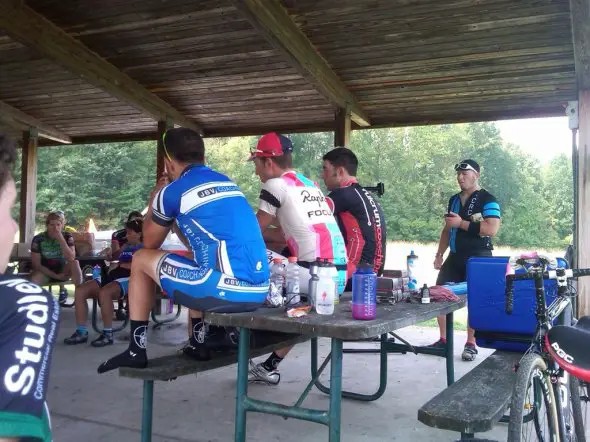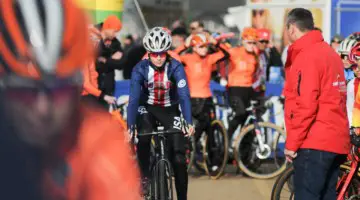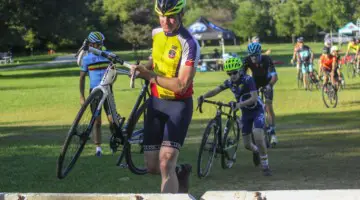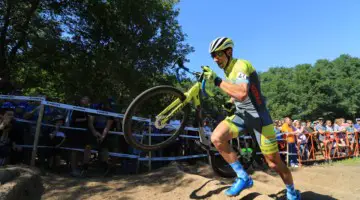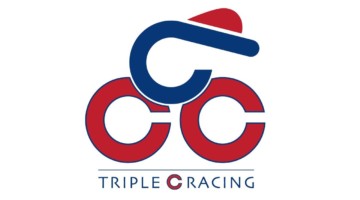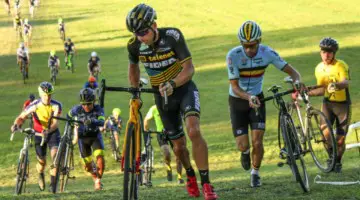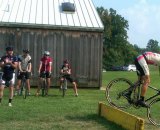
You can learn a lot at a clinic, though you may not be bunny-hopping barriers anytime soon. © Neil Schirmer
Neil is a Masters cyclocrosser in his third season of racing in the Mid-Atlantic region. Bikes and bike racing have always been part of his life, starting with BMX racing as a youngster, evolving into recreational MTB riding in college, eventually ending up in competitive amateur road racing and cyclocross today.
For the 2012 season, his goals are to score points in his local race series, improve his skills, and continue having more fun racing bikes than any adult should rightfully be able to have.
by Neil Schirmer
On September 4th, I was fortunate enough to be able to attend a local skills clinic in Upper Marlboro, Maryland, organized by regional coaching groups JBV Coaching and Fulcrum Coaching. For the past few seasons, they’ve enlisted pro Jeremy Powers to provide expert advice and all-around good vibes, and this year was no exception. Powers came out for a question-and-answer session at local shop, The Bike Doctor of Waldorf, the night before the clinic, and then joined the group to share his expertise and tear it up with the folks for the all-day instructional event on Sunday at Rosaryville State Park.
I went into this clinic with very little by way of preparation for the season, so in many ways this was going to be a jumpstart for the 2011 campaign. After getting my new race bike back from the shop with a fit to match my road machine on the Thursday before the clinic, I’d only had one 30 minute session on it to try and get reacquainted with all of the cyclocross-specific movements and efforts again I was pleased to discover that I could still find my way back on to the saddle on the remounts, and with a little less air in the tires, making tracks in the grass and dirt quickly felt normal again after a long summer of racing on the tarmac.
In the days leading up to the Sunday clinic, I spent a fair amount of time asking a lot of questions of myself. What did I want to get out of this? What are my weaknesses and what do I really need to work on to stay competitive at my local races? Besides the physical skills that needed improvement, I really felt like I need to work on my mental game.
Probably the most difficult lesson to learn after making the switch from “B” to “A” masters racing in my area last year was that mental toughness is something that I needed to improve, dramatically. After a successful run of racing in the first half of last season, call-ups and racing near the front of most races was beginning to feel comfortable and normal in the local “B” Masters field. Road racing fitness carried over nicely into the fall cyclocross racing season and provided a definite edge over much of the competition. No such edge was to be found in the “A” races that I entered at the end of that season, and it was a bit of a shock. Soft skills were harshly exposed, and relatively good fitness was no longer a viable safety blanket under which to hide. Losing pace with the front group was happening early in the races, and other racers were passing by in unfamiliar places with unfamiliar frequency. I was losing confidence, and my brain began to want to call a truce with my body much more quickly. More than anything else, I felt like I needed to check my head this year.
As the coaches called for everyone’s attention underneath a pavilion in the park where the clinic was being held, one of the first things we did was tell the group our name, how many years of cyclocross experience we had and what we wanted to get out of the clinic. My answer to the last question was, “… gain some confidence, and strengthen the muscle between the ears a bit.”
As everyone broke out into groups, I found my way over to the “advanced” folks, since I have several years of racing under my belt. I feel pretty good about the fundamentals of dismounting, mounting, and shouldering – most of the cyclocross-specific stuff is what I feel best about, even though I know I could still be much better at all of them. Cornering, reading a race course and riding deep sand are a different story entirely. These are weak spots and are some of the things I really wanted to work on, if possible. Unfortunately, there was no sand pit on site, so practicing that very specific skill would have to wait for another day. The coach who was with my group for much of the day, Chris Mayhew of JBV Coaching, was very nice and took time during one of the breaks to give me some very specific tips and guidance on how to tackle the sand with more confidence. I’m already looking forward to several local races where I know I’ll be able to put his advice to good use.
Since cornering is such a fundamental technique, I knew it would be covered. The coaches and instructors taped off a mild off-camber mini-course for use during the cornering section of the clinic. After the basics were shared with everyone, we all took turns taking runs through the course, first two at a time, then four at a time, eventually bringing things to a head with some short races. After giving this section a good hard run, I was pleased to discover that the turns were coming a little easier than I had expected. In this instructional context, a lot of my fears and apprehension about my weak spots were starting to melt away. During another break in the action, I approached Chris again and asked, “Is it safe to assume that if we don’t get pulled aside that we’re doing this stuff OK?” I had noticed that up to that point I hadn’t really been singled out for specific redirection as we practiced what we had just learned. Was I to assume that I was doing everything reasonably well? I was pleased to discover that I was nailing everything a bit better than I had expected.
Later on in the day, a slightly larger mini-course was set up so we could put everything we had learned into practice all at the same time. A good fast start, a forced dismount and remount through a barrier section, a 180 degree turn, a few off-camber twists, and a short uphill finish to round it out. I think everyone had a great time battling each other, as well as battling the instructors who were intermittently jumping into the action to spur on a bit of extra competition. I love any sort of competition, and relished the chance to unleash some of the new-found skills on my classmates. “This is the perfect way to top off the day,” I said to myself huffing in the shade after my fourth or fifth pass through the course.
With the shadows growing long, I pulled out of the parking lot and drove home reflecting on the day. A nice feeling came over me as I realized that I was taking home more than I had hoped, and I’m not just talking about the fuzzy cell phone picture of JPow bunny-hopping the barriers. Yeah, I think that’s the feeling of a little confidence creeping in there somewhere, the perfect way to start off the 2011 season.













